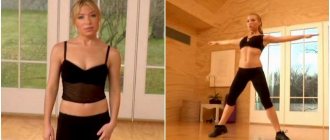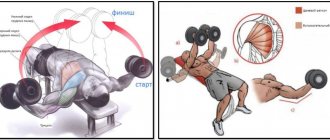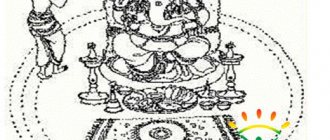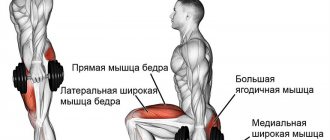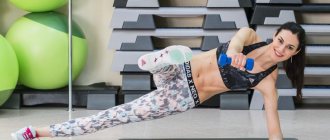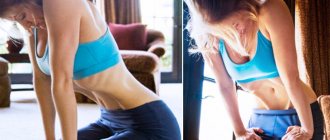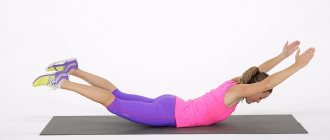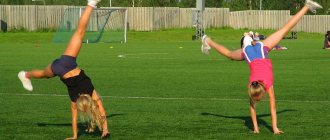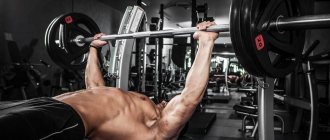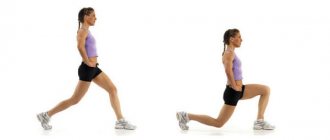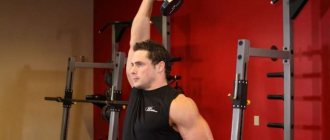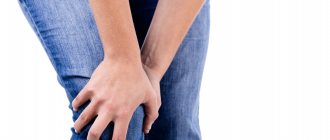≡ March 1, 2020 Category: Exercises by muscle group
Today, a well-groomed body is in fashion, and women are doing everything possible to not only lose weight, but also give their body elasticity and fit, especially in the lower part. One very effective way is to walk on your buttocks. This not only helps to quickly eliminate fat deposits, but also improves health in the pelvic area. It is in this part that there are organs that are responsible for the health of the body as a whole.
How can women benefit from walking on their buttocks?
Walking on the buttocks primarily has a beneficial effect on the female body. Some of the most significant benefits of this workout for women:
- Removing toxins and waste. In the pelvic region there is an area responsible for the digestive tract. By stimulating it through exercise, there is an enhanced removal of harmful substances from the body.
- Elimination of pain during menstruation. Pain during the menstrual cycle occurs due to low blood flow to the uterine mucosa. Walking on the buttocks helps improve blood circulation in the pelvic area and, as a result, reduce pain to a minimum.
- Strengthening the spine. During the exercises, the back muscles are strengthened and joint mobility is increased. This has a great effect on the condition of the spine.
- Treatment of gynecological diseases. Thanks to exercise, blood circulation improves, which has a wonderful effect on the reproductive organs.
- Fight cellulite. When massaging the buttocks on the floor, fat cells are broken down.
- Muscle strengthening and weight loss. During exercise, the muscles of the buttocks, back and abs are tensed, which has a beneficial effect on strengthening and toning them. In this regard, there is a rapid loss of excess centimeters and kilograms.
- Improving the condition of skin and hair. With regular training, the functioning of the digestive system is normalized, which leads to improved metabolism. As a result, the condition of hair and skin improves.
The benefits and harms of exercise
With regular and competent practice, this exercise will strengthen the gluteal muscles, eliminate a common aesthetic problem in women, “orange peel” (cellulite), and also cope with the following conditions:
- Haemorrhoids.
- Constipation.
- Rectal prolapse.
- Adenoma in men.
- Swelling in the legs.
- Enuresis.
Seated walking (hereinafter referred to as “buttocks”) is very often used for the prevention and treatment of gynecological diseases. It improves blood circulation in the pelvic organs, increases reproductive function, adhesions and urinary incontinence. It is often recommended for women to prevent endometriosis, and for men - adenoma.
Of course, if done incorrectly, you can not only waste time, but also cause some harm to the body. With increased training intensity, skin chafing may occur, accompanied not only by hyperemia, but also by unwanted rashes.
Rules for performing the exercise
In order to get the maximum benefits and benefits from walking on your buttocks, you need to follow the step-by-step rules of execution. The recommended time for classes is morning and evening for 10-15 minutes. Just a little time and a little effort will lead to the desired result.
- You need to sit on the floor, on your buttocks, making sure to lay down a special gymnastic or regular mat. Straighten your legs so that there is a right angle between your legs and body. The back should be straight. Important! During the exercise, you need to monitor your posture to avoid injury.
- The arms are bent at the elbows, making a right angle. To complicate the exercise, you can throw your hands behind your head.
- Now the walking itself. At the same time, the right side (right leg and right buttock) is lifted off the floor and carried forward through the air.
- The same action should be performed on the left side. And so on in turn.
While walking, you should focus on the buttocks. But don’t forget to help move with your body.
What rules should you follow?
The Neumyvakin exercise has good positive reviews, but in order for walking on the buttocks to be useful and effective, you should follow some simple rules:
- You should not allow your back to be slouched. While walking on your buttocks, your back should remain flat (90 degree angle between your legs and back). Otherwise, the exercise will be ineffective.
- No need to use your hands. The point of the exercise is to place the entire load on the pelvic muscles. You can only help maintain balance with your hands (wave your arms as if you were running).
- When moving forward, you should try not to drag your leg along the surface and keep it straight.
- For training, it is better to wear smooth pants to avoid the appearance of calluses on your butt. If the skin is still “rubbed”, then the damaged areas can be treated with olive oil or a rich cream.
- You need to start the exercise gradually, avoiding excessive loads. It is recommended to start with 15 exercises, two sets per day. Then increase the number of approaches to 8-9 for 40-50 repetitions.
- It is important to pay attention not to the number of repetitions, but to the correct execution of the exercise technique, and then the results of the training will be noticeable within a month.
Contraindications
The “walking on the buttocks” exercise is suitable for any age category, regardless of physical fitness. But, like any physical activity, it has several contraindications:
- First trimester of pregnancy. During the most risky period of pregnancy, it is worth giving up physical activity, because this can cause uterine hypertonicity and even provoke a miscarriage.
- Menstrual days. When walking on the buttocks, pressure occurs on the stomach and abdominal cavity, which can cause endometrial detachment.
- Exacerbation of hemorrhoids. During physical exercise, tension and friction occur in the buttocks. This can contribute to prolapse of hemorrhoids and even bleeding.
- Pain in the abdomen and lower back. If you experience pain in the abdomen or lower back, doing exercise may increase the pain.
Feedback about this exercise
Elena, Pyatigorsk, 27 years old
“I found such classes difficult at first. But after a couple of weeks of working at home, I got quite used to it and started doing them every day, as advised. Within a month the effect was amazing – my butt tightened, I felt lightness in my lower back, I became more cheerful and cheerful!”
Oleg, Moscow, 35 years old
“A specialist recommended such classes when I came to him with problems in the “personal sphere.” I combined seated gluteal training with medication treatment - after a couple of weeks I noticed relief, it became easier to go to the toilet, and there was less pain in the lower abdomen.”
Pros and cons of glute walking
As with any physical activity, butt walking also has its advantages and disadvantages. Pros:
- Absolutely non-traumatic type of exercise. It is simply impossible to get injured while sitting on the floor.
- Even a person with little training in sports can easily perform this physical therapy exercise.
- Saving. Buttock walking can be done at home without spending money on a gym membership. Actions to combat cellulite can be easily done on your home mat.
There are also some disadvantages:
- Butt walking is not comparable in load to a full workout in the gym. For beginners, this is the best option. But for more advanced athletes, it looks more like a warm-up. And along with this walking, they need to do additional exercises.
- Such walking is not fully capable of working the gluteal muscles. This is just superficial training. To improve the effect of elasticity of the buttocks, it is necessary to supplement it with deep squats.
How to replace this exercise in the gym?
Among the main special exercises that are often recommended as a replacement for the gluteal movement, I can note the following:
Pushing the leg up
In addition to the gym, you can do it at home. Starting position - on all fours, on the floor. The knees are straightened along the hip line at shoulder level. One leg bends and lifts back up to 90 degrees with the floor (heel points to the ceiling.)
Lunges
Starting position – stand straight. Bend your leg and put it forward. We bring the thigh into a position parallel to the ground - in other words, we lunge forward with one leg and squat on it.
Bridge
Starting position – lie on your back on the floor, hands on the floor at the sides of your body. Raise your hips up, resting your back on the floor and hold the position for 10-15 seconds, strongly squeezing your gluteal muscles.
I would like to clarify that these special exercises, although they can be considered quite effective when working at home/in the gym, nevertheless, they are not a complete replacement for sitting movements, both in terms of their comprehensive effectiveness and ease of execution.
What kind of exercise is this
Pumping up the muscles of the buttocks is a sure way to improve their shape, get rid of fat deposits in this area and improve the functioning of the pelvic organs.
Walking on the buttocks is considered one of the most intense and effective exercises for this muscle group. This type of movement was initially included in treatment programs and included performing other exercises in combination.
Did you know? Walking on the gluteal muscles was first proposed and demonstrated by Dr. I. P. Neumyvakin in the 1970s. He developed exercise therapy to improve bowel function, and this exercise proved to be key in the recovery of his patients.
Over time, the effect of walking on the buttocks was recognized as so effective that it began to be performed separately from other exercises. Walking of this kind tightens the gluteal muscles and stimulates intestinal motility, the main part of which is located in the stimulated area.
Let's start with a warm-up
To avoid injuring yourself during this intense exercise, warm up and stretch your muscles beforehand. Make smooth rotational movements with your head, shoulders, smooth bends back and forth, and stretch your pelvis.
Do 10–15 squats and 3 swings of one and the other leg in each direction. To warm up the muscles of the gluteal region, lie on your back and alternately pull one or the other knee to your chest with your hands.
Hold your knee to your chest for 20–25 seconds to stretch the muscles, then switch legs. At the end of the warm-up, pull 2 bent legs to your chest at once and rock slightly on your back.
Check out this set of pre-workout warm-up exercises.
Reviews
Inessa Voloshina, Omsk My personal result of walking on the buttocks: cellulite is gone by 70 - 80 percent. Of course, there is not always enough time. You still need to push harder to make it perfect. But the butt became smaller and more toned. Natalya Sergeeva, Ulan-Ude What I want to say about an important advantage: walking on your buttocks is not dangerous. I had an experience where I overloaded a joint, it took a long time to recover, and I had to look for gentle options for exercises for the buttocks. Walking on your butt helps! Tested for yourself! Tatyana Kryukova, Togliatti I tried to walk on my butt. At first I didn’t notice any results and “got blown away” and left the matter. And then the nurse advised me to break up the bumps from the course of injections. I had to do it for almost a month. And the bumps were gone, and my butt really became stronger. So walking on the “fifth point” really strengthens the buttocks, but you can’t quit right away. Now I’ve got a taste for it and do it regularly. Did you find this article useful? Not really
How to do it right
There are about 10 options for performing this exercise, but the following 3 are considered the most effective.
First
Before starting a class, lay a mat, yoga mat, or just sit on your home carpet. It will give you stability and enhance the effect of the exercise.
- Sit on the mat, stretch your legs in front of you and spread them slightly to the sides. Bend your arms as if you are about to run fast.
- Tighten your buttocks and push one off the floor, taking a “step” forward. Immediately “step” the next buttock. Remember to move your arms - they should move as if you were walking normally.
- When you reach the end of the mat, stop and start moving back. Don't help yourself with your hands and try to keep your back straight.
Important! Since walking on the buttocks stimulates blood circulation in the pelvic organs, women should avoid it during their period.
Second
This is a complicated version of the first classical way of performing the exercise.
- Sit on the mat, stretch both your arms and legs in front of you.
- When you first “step” with your buttocks, turn your head in the direction of the step and extend your arms in the opposite direction.
- Repeat the same sequence for the second buttock.
- Make the reverse movement with your arms bent and pressed to your body.
Third
Used to train the sense of balance.
- Sit on the floor, clasp your fingers and place them behind your head.
- With each “step,” lift your straight leg slightly off the floor with your buttock. This option is suitable for those who, in addition to strengthening their buttocks, plan to pump up their abdominal muscles.
We recommend reading about how to properly do lunges with dumbbells for the buttocks.
